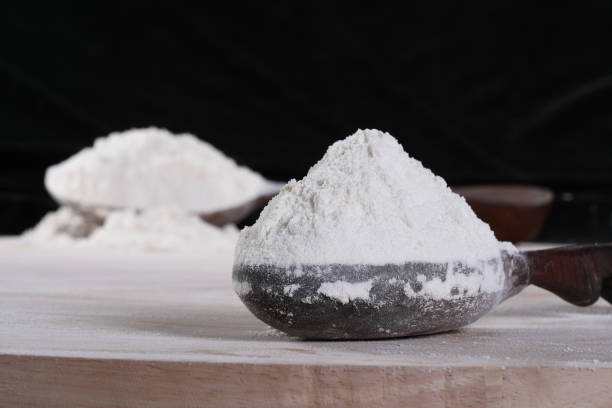Starch is a tasteless carbohydrate, usually white in color and insoluble in solvents. Starch foods are highly rich in carbohydrates and play a crucial role in balancing your diet. They are essential in providing the body with carbohydrates, supplements, fibers, and glucose. It is a natural polymer consisting of sugar molecules and exists in two forms; amylopectin and amylose. Amylose starch is a natural polymer that is liner/straight-line. Alternatively, amylopectin is a starch polymer that forms branched chains. Having discussed what starch is, let us examine this product’s health benefits and uses.
1. Source of Energy
Starch is a crucial source of energy in the human body. Daily intake of starch foods may improve the energy levels of your body. After taking foods rich in starch, the body digests and is metabolized it into glucose, which initiates body energy. The metabolized glucose is then passed into the other parts of the body and the bloodstream. In addition, if the starch is produced in excess, it is stored in the liver as glycogen for future usage.
2. Source of Fiber
Starch foods are fully packed with fibers. Starchy foods such as whole grains, corn, and beets are rich in fiber that the body needs. In the body, fiber supplements are insoluble, and thus they add bulk to the bowel. This helps to prevent the effects of constipation and promote the functioning of the bowel.

3. Skin Relief
Starch products are the remedy to skin disorders and rashes. The properties found in starch foods are capable of alleviating skin defects. Applying the cornstarch product to the affected region helps in soothing the irritation and reducing the inflammation effects. In addition, starch products can be used to soothe sunburns and reduce the redness caused to the skin.
4. Bug Bite Relief
Bug bites may be disturbing and may cause skin itchiness. Several workarounds can be used to fit the bug bite itchiness. Starch products may help to fix the itchiness and irritation caused by the bug. Applying the starch product around the affected area helps the skin cells to dry and its cells to relax. The relaxation of cells around the affected area alleviates the itchiness.
5. Source of nutrients
Starch is a highly nutritional compound; thus, it is critical to the well-being of the body. Starchy foods are highly rich in carbohydrates. Carbohydrate is the engine of the body. It is responsible for producing glucose, which supplies the body with energy. To have a balanced diet, you must include starch food in your list.
6. Thickeners and stabilizers
Starchy foods are used as stabilizers and thickeners while preparing some dishes. Starch supplements are used as the thicker in the production of puddings, soups, sauces, and salad dressings. The starch compound is made up of tightly connected sugar chains that promote the thickening of the dish being prepared.
7. Used as Antiadherent
The starch powder can be used as an anti-adherent agent in baking. When used for this purpose, the starch powder helps reduce the adhesion between the powder and the hands during baking. In addition, this anti-adherence property is applied in the production of tablet drugs. The starch supplement helps reduce the friction caused by interposing the tablet’s layer and the walls.
8. Tablet Disintegrant
Starch is widely used in coating many tablet-based drugs. The starch is rich in disintegrant products, allowing the tablet to break down after oral administration. The starch compound can separate into particles when in contact with a solvent.
9. Production of Artificial red cells
Besides producing glucose, starch benefits the body by producing artificial red cells. Some starchy products like potatoes are affluent in starch and other nutrients needed to make red cells. In the body, the compounds of the potato encapsulate the hemoglobin, which leads to the production of artificial red cells and improves the oxygen levels in the body.
10. Production of polymers
A polymer is a molecular structure built from bonded two or more units. Starch has a unique role in producing polymers used for various applications. Some starch-related polymers are used in manufacturing therapeutic drugs and making gel-forming products.
11. Used as Glidant
Starch is rich in flowability properties, and thus it can be used as a glidant. During baking and other kitchen applications, starch products are used to enhance the powders or granules’ flow ability. Therefore, it helps to reduce the cohesion and friction that is likely to occur while baking.
12. Tropical production
Starch is fully packed with absorbency properties. Starch products are used in the tropical preparation process to add absorbency properties to the liquid. For example, starch from rice and wheat is used in tropical formulations. In addition, starch products are used in ointment preparations.
13. Blister Relief
Blisters may be painful and disturbing at the same time. Starch supplements can be used to alleviate the symptoms caused by the blisters. Adding cornstarch or any other powder starch around the affected area helps reduce inflammation and keep the area dry. However, starch supplements should not be used on open wounds.
14. Cleaning purposes
The anti-adherent properties found in starch products are vital in cleaning tasks. When used for cleaning, starch properties break the dirt, thus easing the greasing process.
15. Used as Deodorant
Starch products are suitable for masking odor. These products are rich in moisture and odor-absorbing properties that act as a deodorant. In some cases, chemical deodorants may be expensive and not readily available. Starch products like cornstarch can acts as natural deodorants and can be used to serve the same purpose as the over counter deodorants.
16. Used as Binder
Starch products are used as a binder in the wet granulation process. The starch compound has chains and particles attached together, thus promoting the binding force needed in the granulation process. In the production of tablets, starch is used as the binder and coating of drug particles.




